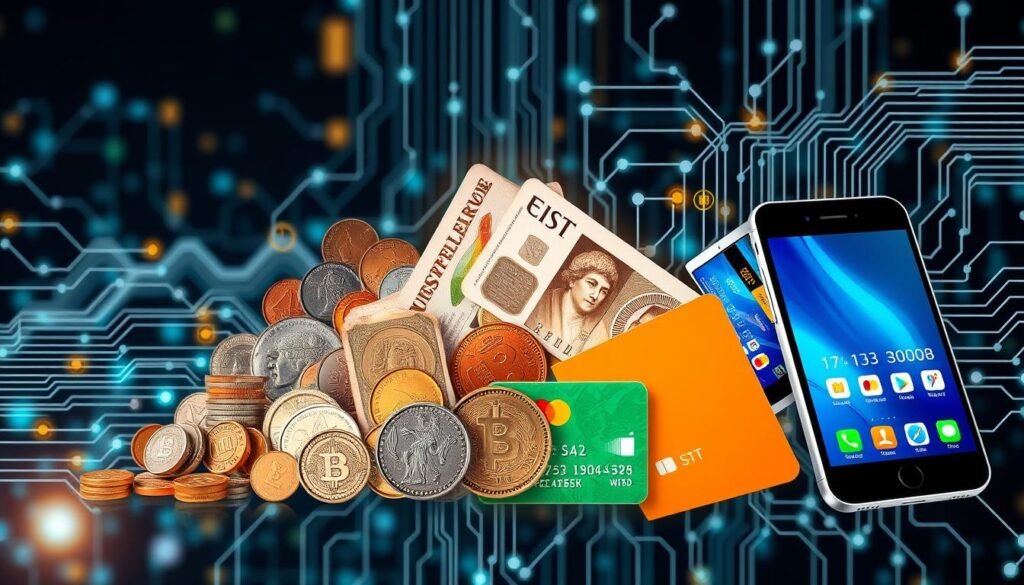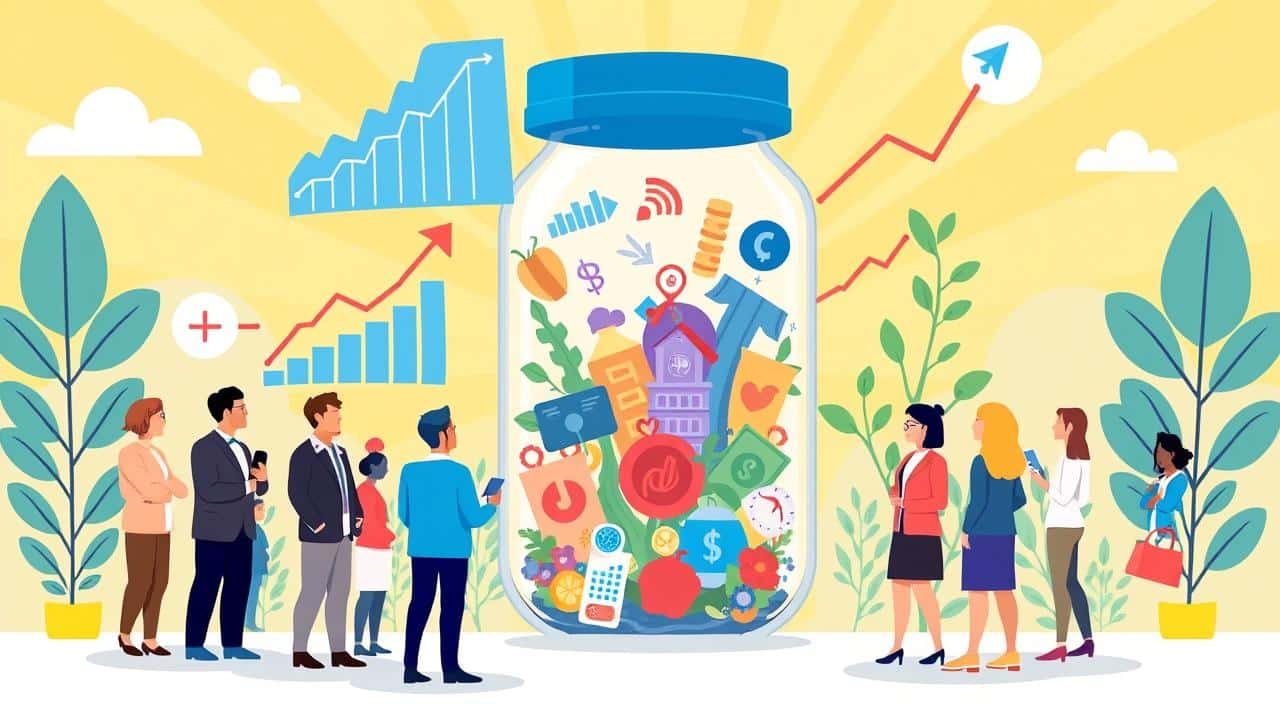The world of payment systems has changed a lot. We used to pay with cash, but now we mostly use digital ways. The Federal Reserve Payments Study shows more people are using cards and the ACH system. This means we’re moving away from cash.
Debit cards and mobile payment apps like Apple Pay are becoming more popular. They offer security and ease of use. This change has been especially big during the COVID-19 pandemic.
Outside the U.S., the payment world is changing too. In the euro area, 47% of transactions were card payments in 2020. In the U.S., debit cards made up 28% of electronic payments that year. Contactless payments and digital assets like cryptocurrencies are also growing fast.
Key Takeaways
- The use of non-cash payment methods, such as cards and ACH, has seen significant growth in the United States, indicating a shift away from traditional cash-based transactions.
- Digital payment solutions, including mobile wallets and peer-to-peer payment apps, have gained widespread adoption, particularly during the COVID-19 pandemic.
- Globally, the payment landscape is also undergoing transformation, with card payments and contactless payments becoming more prevalent in various regions.
- The rise of cryptocurrencies and other digital assets has introduced new payment options, further diversifying the payment ecosystem.
- Technological advancements, such as data encryption and biometric authentication, have enhanced the security and convenience of digital payment systems.
The Significance of Payment Systems
Payment systems are key to financial inclusion, economic growth, and the digital economy. The World Bank Group (WBG) leads in this area. It helps countries improve their payment systems in over 120 nations.
Enabling Financial Inclusion
The WBG helps set up important payment systems like Automated Clearinghouses (ACH) and Real Time Gross Settlement (RTGS) Systems. It also supports Fast Payment Systems (FPS), Central Security Depositories (CSD), and Securities Settlement Systems (SSS). This work increases access to financial services for more people, boosting financial inclusion.
Supporting Economic Development
Payment systems are essential for business transactions. The WBG works with donors to innovate payment systems. This supports economic growth for businesses of all sizes.
Fostering the Digital Economy
Digital payment systems are vital for the digital economy. The WBG helps countries follow best practices like the CPMI–IOSCO Principles for Financial Market Infrastructures (PFMIs). This ensures payment systems are strong and efficient, helping the digital economy grow.
| Metric | Value |
|---|---|
| Countries with payment systems reforms supported by the WBG | Over 120 |
| Countries where remittances account for 3% or more of GDP | More than 60 |
| Year the Federal Reserve launched the FedNow® instant payment service | 2023 |
Payment systems do more than just handle transactions. They support financial inclusion, economic growth, and the digital economy. This makes them crucial for the overall economic and social landscape.
“The World Bank Group has been a driving force in advancing the global payment systems agenda, supporting countries in their efforts to build resilient and inclusive financial systems.”
Domestic Payment Systems

Domestic payment systems are key in the financial world. They help move money between banks. They handle all kinds of payments, from urgent to non-urgent ones.
Automated Clearing Houses (ACH)
The automated clearing house (ACH) is a big player in these systems. It deals with transactions in batches, which can be risky. But it’s great for things like bills and direct deposits.
Real-Time Gross Settlement (RTGS)
Real-time gross settlement (RTGS) is different. It settles transactions right away, without delay. It’s perfect for urgent, high-value payments, keeping the financial system running smoothly.
Instant Payment Systems
Then there are instant payment systems that work all the time. They aim to finish transactions in just 10-15 seconds. They make paying easy and fast for everyone.
“Domestic payment systems are the backbone of the financial ecosystem, enabling the smooth flow of funds and supporting economic growth.”
Payment Systems: Global Landscape

The global payments industry has grown a lot, reaching $2.1 trillion in 2021. This is an 11% jump from the year before. The Asia-Pacific and EMEA regions led this growth, each seeing a 13% increase in revenue.
Electronic transactions have also seen a big rise. Debit card use is now more than credit cards worldwide. This change has made the industry grow fast.
Cross-Border Payment Challenges
Globalization has increased cross-border payments a lot. But, old international payment systems like STEP2 and TARGET2 are slow, prone to errors, and costly. They were made a long time ago and can’t handle today’s cross-border transactions well.
These systems face many challenges. They struggle with the variety of payment tools, the complexity of supply chains, and the rise of online shopping.
Existing International Payment Systems
The Eurosystem runs two key payment systems: STEP2 and TARGET2. STEP2 handles euro credit transfers and direct debits across Europe. TARGET2 is for fast, high-value euro payments.
These systems are vital for global payments in the European Union. But, they need to change to keep up with today’s financial world.
| Payment System | Description | Key Features |
|---|---|---|
| STEP2 | Pan-European automated clearing house (ACH) for cross-border and domestic euro credit transfers and direct debits |
|
| TARGET2 | Real-time gross settlement (RTGS) system for the euro |
|
The global economy keeps changing, making fast and cheap cross-border payments more important. The problems with old international payment systems show we need new, better solutions.
Emerging Trends in Payment Systems
The world of payment systems is changing fast, thanks to FinTech. New trends include e-money, fast payment services, and central bank digital currencies (CBDCs). We’re also seeing more open banking, tokenization, and QR codes. The World Bank and IMF have started the Bali FinTech Agenda to help countries grow their fintech. In 2022, the World Bank released a report on Fintech and the Future of Finance.
FinTech Revolution
The FinTech industry is leading the charge in payment system innovation. New digital tech like mobile payment apps and blockchain-based solutions are changing how we pay. Peer-to-peer (P2P) payment platforms and digital payment methods in e-commerce are making payments easier and faster.
Central Bank Digital Currencies (CBDCs)

Central bank digital currencies (CBDCs) are another big trend. Central banks are looking into CBDCs to make payments better. They could bring faster transactions, better financial inclusion, and more control over money.
Open Banking and APIs
Open banking and application programming interfaces (APIs) are changing finance. Open banking lets customers share their financial info with new services. This could lead to more financial inclusion, competition, and a stronger digital economy.
| Trend | Key Highlights |
|---|---|
| FinTech Revolution |
|
| Central Bank Digital Currencies (CBDCs) |
|
| Open Banking and APIs |
|
“The payment systems landscape is evolving rapidly, driven by the FinTech revolution. Emerging trends include the rise of e-money, fast payment services, central bank digital currencies (CBDCs), open banking, and the use of technologies like tokenization and QR codes.”
Also Read : Understanding The Financial Market: A Beginner’s Guide To Investing
Conclusion
The journey of payment systems has been amazing, moving from cash to digital payments. These systems are key for financial inclusion and economic growth. They help the digital economy thrive.
Domestic systems like ACH and RTGS are essential for smooth fund transfers. New instant payment systems also play a big role. They keep financial markets running smoothly.
But, cross-border payments face big challenges. This calls for new solutions. FinTech, CBDCs, open banking, and APIs are changing the game.
These changes will make payments faster, safer, and more accessible. They will help both consumers and businesses.
As payment systems evolve, it’s important for everyone to work together. Policymakers, banks, and tech companies must ensure these systems are safe and efficient. By doing this, they will help the digital economy grow and include more people.
FAQs
Q: What are the main types of payment systems that exist today?
A: The main types of payment systems that exist today include retail payment systems, digital payment systems, and mobile payment systems. Each of these systems serves different purposes and utilizes various payment instruments to facilitate transactions.
Q: How has e-commerce influenced the evolution of payment systems?
A: E-commerce has significantly influenced the evolution of payment systems by increasing the demand for secure payment methods. As online shopping became popular, the need for reliable, fast, and secure payment transactions grew, leading to the development of various digital payment solutions.
Q: What role do the Federal Reserve System and the European Central Bank play in payment systems?
A: The Federal Reserve System and the European Central Bank are responsible for overseeing and regulating payment systems within their respective regions. They ensure the smooth operation, security, and efficiency of payment transactions while also providing governance of payment systems.
Q: What are secure payment methods and why are they important?
A: Secure payment methods are transaction processes that protect sensitive payment information from fraud and unauthorized access. They are important because they help build consumer trust in payment systems and e-commerce, ensuring that transactions for goods and services are safe.
Q: How do payment systems in emerging markets differ from those in developed countries?
A: Payment systems in emerging markets often rely on mobile payment solutions and alternative payment instruments due to limited access to traditional banking services. In contrast, developed countries have more established banking infrastructure and diverse payment systems that include credit and debit cards like Mastercard.
Q: Can you explain the process of a payment transaction from one bank account to another?
A: A payment transaction from one bank account to another typically involves the sender initiating a transfer through their bank, which verifies the transaction details. The funds are then transferred through the payment systems to the beneficiary’s bank, where they are credited to the recipient’s account.
Q: What services are provided by modern payment systems?
A: Modern payment systems provide a variety of services, including facilitating secure payment transactions, enabling e-commerce, offering mobile payment solutions, and allowing for the transfer of funds from one bank account to another. They also support various payment instruments and ensure compliance with regulatory standards.
Q: How do the governors of the Federal Reserve influence payment systems?
A: The governors of the Federal Reserve influence payment systems by setting policies and regulations that govern the development and governance of payment systems. Their decisions impact the overall stability, security, and efficiency of payment transactions within the financial system.
Q: What challenges do payment systems face in adapting to new technologies?
A: Payment systems face challenges such as the need for continual updates to secure payment methods, the integration of new technologies, and the potential for cybersecurity threats. Additionally, regulatory compliance and ensuring user trust in new payment instruments are ongoing concerns for the development and governance of payment systems.
Source Links
- https://www.britannica.com/money/types-of-payment-systems
- https://whitepay.com/news/the-evolution-of-payment-systems-from-cash-to-digital-transactions
- https://www.forbes.com/councils/forbestechcouncil/2024/06/11/the-evolution-of-payments-in-the-us-and-europe/
- https://www.worldbank.org/en/topic/paymentsystemsremittances
- https://www.federalreserve.gov/aboutthefed/fedexplained/payment-systems.htm






